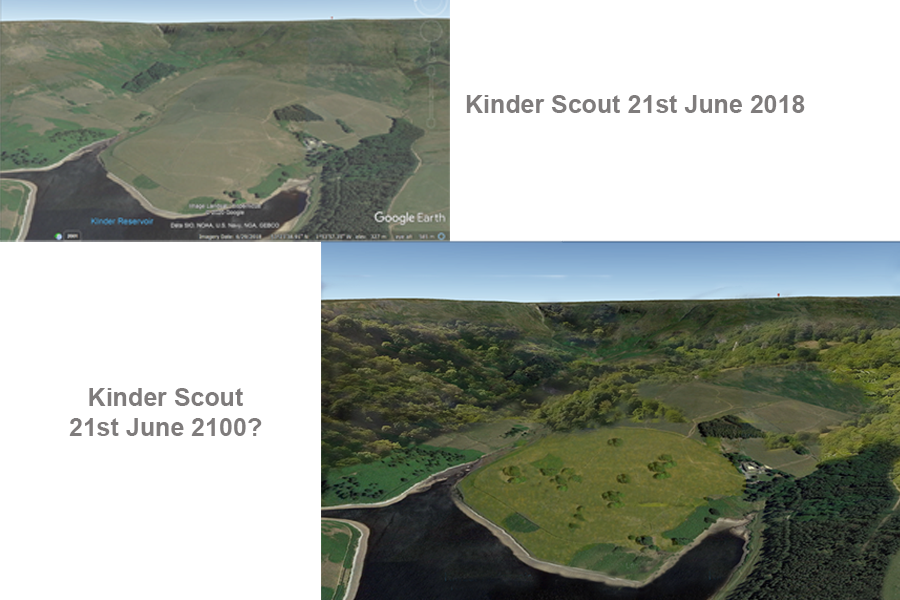Visions of Kinder Scout in 2100 – a thread.
Here’s how I hope to see Kinder Scout in 80 years, inspired by @Alexander_Lees recent blog for @DerbysWildlife, https://www.derbyshirewildlifetrust.org.uk/blog/envisioning-brighter-future-birds-dark-peak.">https://www.derbyshirewildlifetrust.org.uk/blog/envi...
Here’s how I hope to see Kinder Scout in 80 years, inspired by @Alexander_Lees recent blog for @DerbysWildlife, https://www.derbyshirewildlifetrust.org.uk/blog/envisioning-brighter-future-birds-dark-peak.">https://www.derbyshirewildlifetrust.org.uk/blog/envi...
This is the comparison of Kinder reservoir and Scout now and how it might be. Of course to get there, many trade-offs and changes have to be made. Below are some of my views on how we could get there…
1.First the upland plateau. A higher water table, end of rotational burning and a more varied vegetation structure means slower water run-off (less flooding), increased carbon storage and more breeding waders like golden plover and dunlin. https://twitter.com/mostlyrambling/status/1241668374909853698?s=20">https://twitter.com/mostlyram...
Of course, the end of burning means trees regenerating on the moorland. But as @Rebirding1 suggests in his excellent book, grazing with ungulates like Dartmoor ponies and cattle can maintain an open ecosystem. https://twitter.com/JanFreedman/status/1243198389468254208?s=20">https://twitter.com/JanFreedm...
This sort of land management is unlikely to support the numbers of red grouse needed for driven grouse shooting, a major source of income for upland areas - although still a relatively poor use of land in economic terms. Alternatives needed.
Alternative sources of income could include various other forms of shooting, payments for ecosystem services (flood prevention, water storage/cleaning, carbon storage) and a few more creative ideas… https://twitter.com/Independent/status/674009751244562433?s=20">https://twitter.com/Independe...
The switch from primarily grazing sheep to cattle allows for of high quality, environmentally friendly beef (like this example http://grassfedbeef.co.uk/ ),">https://grassfedbeef.co.uk/">... albeit in low quantities as a premium product.
2.Without the raptor persecution associated with driven grouse shooting https://www.nature.com/articles/s41467-019-09044-w,">https://www.nature.com/articles/... a range of birds can thrive on the cliffs, such as golden eagle, peregrine falcon and raven. Tourism for ospreys at Loch Garten RSPB brings in £1.7m p.a.
3.The lower slopes, free of grazing pressure from sheep, can return to broadleaf rain forest. Havens of wildlife that can support a range of struggling and locally extinct species, like wood warbler, pied flycatcher, black grouse, red squirrel, pine marten, wild boar and lynx.
Wildlife hides for photography can be charged out for ~£100 per person for a few hours https://wildlifephotographyexperiences.com/tour/scotland-photography-workshop/,">https://wildlifephotographyexperiences.com/tour/scot... and ~£200 for lynx https://www.iberianlynxland.com/copia-de-hide-de-la-charca">https://www.iberianlynxland.com/copia-de-... and are extremely popular.
The natural abundance of many species in healthy ecosystems will allow for sustainable hunting. A switch to trophy-hunting (shown to be effective in land conservation in many parts of Africa https://thecritic.co.uk/issues/january-2020/the-true-value-of-trophy-hunting/),…">https://thecritic.co.uk/issues/ja...
and rough/walk-up shoots for a range of species at low density, such as red and black grouse, rabbit, hare, fox and roe deer can replace much or all of the lost income from DGS.
And the reintroduction of some apex predators like golden eagle and lynx will reduce numbers of meso-predators like foxes. Meaning that ground-nesting birds will have better luck raising chicks.
Other sources of income can come from traditional forestry practices, coppicing for hard wood and selling wild mushrooms, fruit and nuts (or selling licenses to forage). https://www.finefoodspecialist.co.uk/mushrooms ">https://www.finefoodspecialist.co.uk/mushrooms...
Forests on the lower slopes and cloughs act as effective fire breaks, hold up flooding and store carbon. https://issuu.com/peakdistrict/docs/clough_woodlands_dark_peak_guiding_principles_2019">https://issuu.com/peakdistr...
4. The fields by the reservoir are turned over to hay meadows, alongside rough scrub, to support cattle farming. Abundant sources of seeds and nesting places mean that many struggling birds can thrive like twite, yellowhammer, corn bunting and linnet.
http://ww2.rspb.org.uk/Images/Peak%20Birds%20Issue%205_tcm9-169047.pdf">https://ww2.rspb.org.uk/Images/Pe...
http://ww2.rspb.org.uk/Images/Peak%20Birds%20Issue%205_tcm9-169047.pdf">https://ww2.rspb.org.uk/Images/Pe...
The wettest parts of the meadows are full of lapwing, curlew, redshank and snipe. https://twitter.com/gow_derek/status/1139967031929950208?s=20">https://twitter.com/gow_derek...
5.Small areas of commercial forestry provides another source of income and carbon capture, alongside habitat for nightjar, tree pipit, woodlark, long-eared owl, osprey and goshawk.
Some additional thoughts: This vision seems radically different to the current circumstances of Kinder Scout, yet the main land usages are unchanged – grazing, shooting, forestry and tourism. Just the quantities and species involved need tweaking to bring huge diversity gains.
Making big changes to current and proven economic models can seem risky. But the biodiversity and climate crisis are an imminent threat to business-as-usual, and diverse income streams are more likely to be resilient to these stresses vs intensive production of single species.
Wildlife does best in places where it pays for itself. Sustainability has to include both the wildlife and the livelihoods of the people who live there.
For many conservationists that might mean embracing some unpalatable choices, such as trophy hunting, or even taking young raptor chicks for falconry. If wildlife is abundant and ecosystems healthy, for me this is a worthwhile trade-off.
That might seem regressive when we are still suffering from overexploitation of natural resources. But I believe that in the age of citizen science, big data and even bigger models, we can monitor and adjust resource use to sustainable levels.
I am not advocating this for all of upland Britain (at least initially). There is a reliance on ecotourism, which obviously has diminishing returns as it becomes increasingly widespread.
But within our national parks, set aside to preserve our national heritage, systems based on tourism can work, and far more needs to be done to restore sustainability and healthy ecosystems.

 Read on Twitter
Read on Twitter



